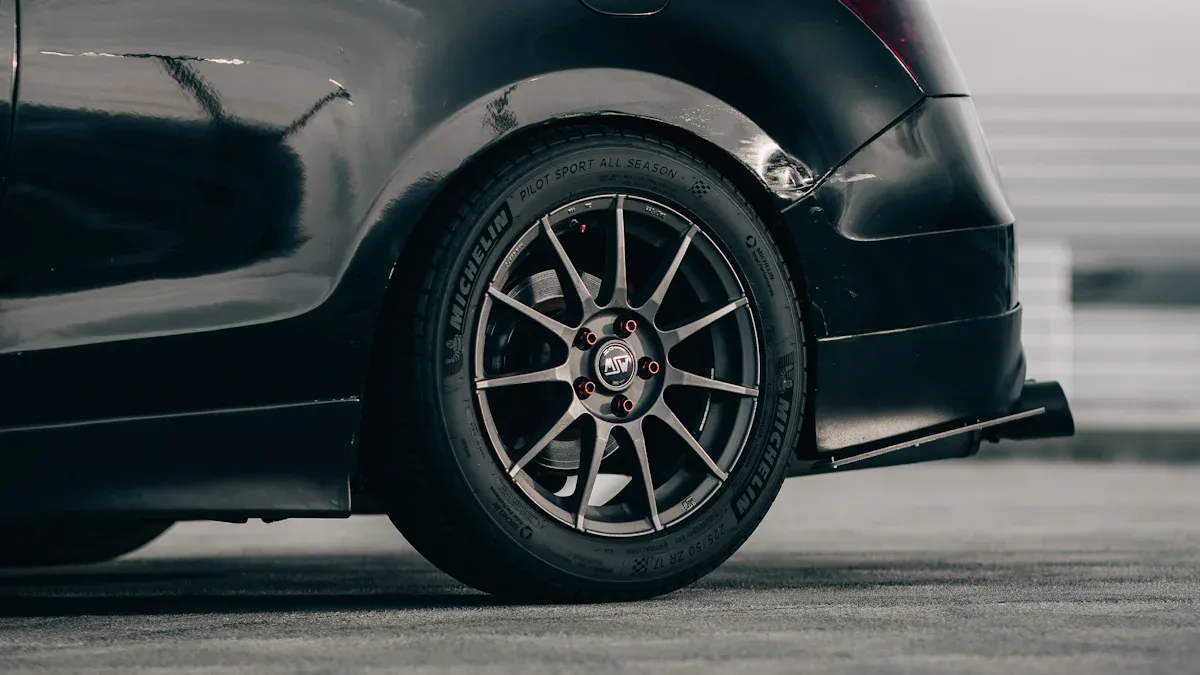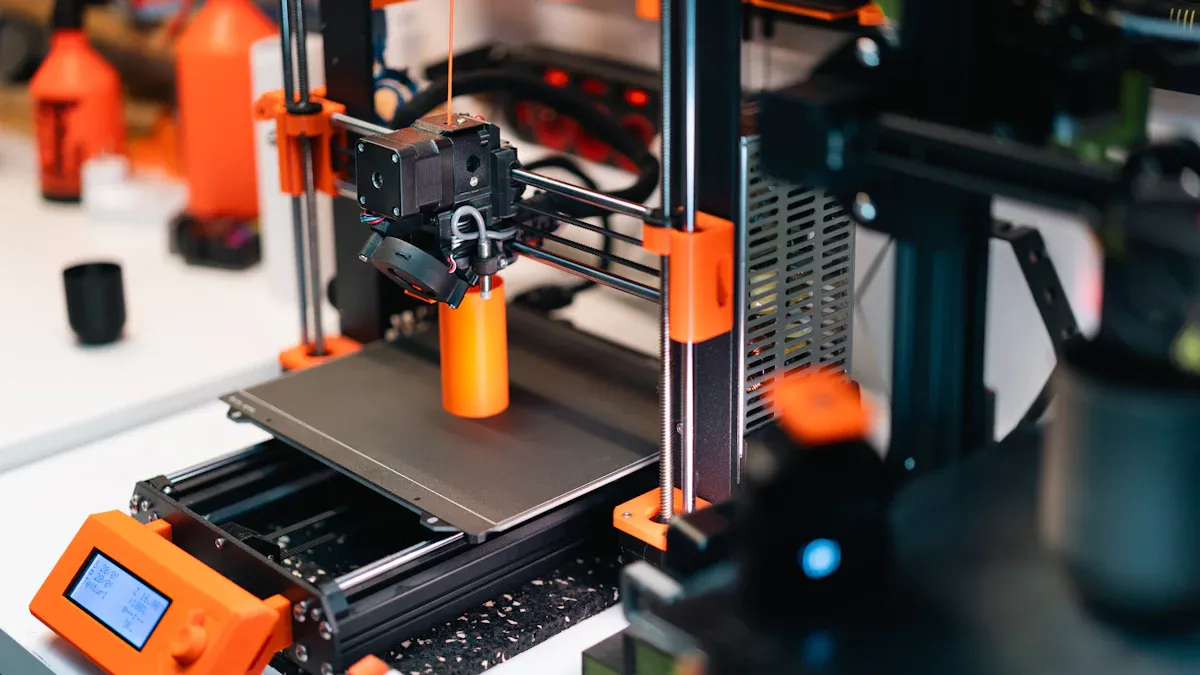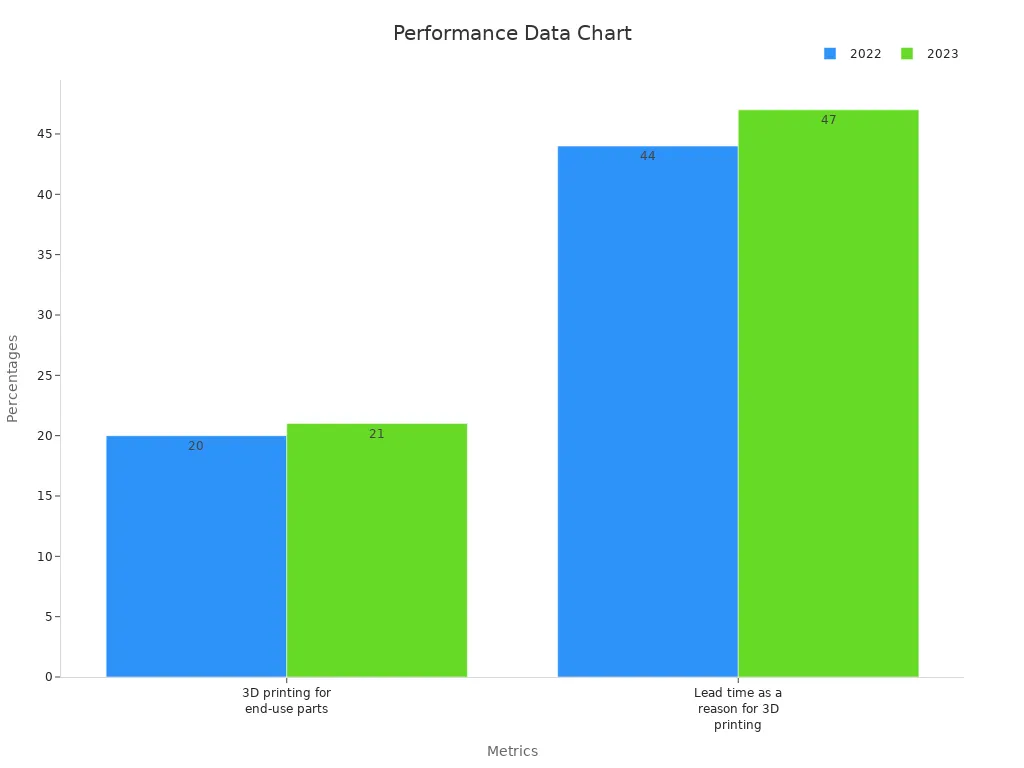
Understanding automotive industry shifts is crucial for staying competitive. As a plastic part manufacturer, you must adapt to trends shaping the future of vehicles. Polymer demand for passenger vehicles is rising by 3% annually, with forecasts showing an increase from 20 million tonnes in 2023 to 34 million tonnes by 2040. These shifts, driven by global vehicle production growth, emphasize the need for innovation. Lightweight materials, like engineering plastics, are replacing metals to meet fuel efficiency goals. By aligning with sustainability and technological advancements, you can secure your place in this evolving landscape.

Sustainability has become a cornerstone of the automotive industry's evolution. As a manufacturer, you must embrace sustainable practices to meet growing environmental demands and align with global trends. This shift is reshaping how vehicles are designed and produced, with a strong focus on recycled plastic compounds, bioresins, and regulatory compliance.
Recycled plastic compounds are transforming automotive manufacturing. These materials, derived from post-consumer and post-industrial waste, offer a cost-effective and environmentally friendly alternative to virgin plastics. By using recycled materials, you can reduce emissions and contribute to a circular economy.
The market for recycled plastic compounds is expanding rapidly. In 2025, it is projected to reach USD 3.73 billion, growing to USD 6.57 billion by 2034 at a compound annual growth rate (CAGR) of 6.50%. This growth reflects the increasing demand for lightweight materials in electric vehicles (EVs), which rely on innovative plastics to enhance battery systems and improve safety.
| Year | Market Size (USD) |
|---|---|
| 2025 | 3.73 billion |
| 2034 | 6.57 billion |
Switching to recycled plastic compounds not only reduces costs but also supports sustainable production. By integrating these materials into your manufacturing processes, you can align with industry trends and meet consumer expectations for eco-friendly vehicles.
Bioresins are gaining traction as a key component of sustainable manufacturing. These plant-based materials offer a renewable alternative to traditional petroleum-based plastics. By adopting bioresins, you can reduce your reliance on fossil fuels and lower emissions during production.
The use of bioresins also aligns with consumer preferences for greener products. Many automotive companies are incorporating bioresins into interior components, such as dashboards and seat covers, to enhance sustainability. This shift not only reduces environmental impact but also positions your brand as a leader in sustainable innovation.
Regulations play a critical role in driving sustainability within the automotive industry. Governments worldwide are implementing policies to promote sustainable production and reduce environmental harm. For example, the European Union's Circular Economy Practices require manufacturers to prioritize recycling and secondary input uses in automotive production.
| Regulatory Measure | Impact on Sustainable Practices |
|---|---|
| EU Circular Economy Practices | Advanced recycling requirements and secondary input use mandates. |
| EU Deforestation Regulation | Promotes sustainable sourcing by halting forest destruction. |
These regulations encourage you to adopt recycled plastic compounds and bioresins, ensuring compliance while supporting global sustainability goals. By staying ahead of regulatory trends, you can avoid penalties and maintain a competitive edge in the market.
Technological advancements are reshaping automotive manufacturing, especially in the realm of plastic parts production. These innovations are not only improving efficiency but also enabling manufacturers to meet the growing demands of the automotive industry. From 3D printing to automation and Industry 4.0 integration, these technologies are transforming how vehicles are designed and produced.
3D printing, also known as additive manufacturing, has become a game-changer in plastic parts production. This technology allows you to create complex designs with precision while reducing material waste. It is particularly useful for prototyping and low-volume production, but recent advancements are making it viable for higher production volumes as well.
The efficiency of 3D printing is evident in its growing adoption. In 2023, 21% of end-use parts were produced using 3D printing, up from 20% in 2022. Lead time reduction remains a key driver, with 47% of manufacturers citing it as a reason for using 3D printing, compared to 44% in 2022. Additionally, 82% of manufacturers reported cost savings from this technology in 2023.
| Metric | 2022 | 2023 |
|---|---|---|
| 3D printing for end-use parts | 20% | 21% |
| Lead time as a reason for 3D printing | 44% | 47% |
| Cost savings from 3D printing | N/A | 82% |

Experts like Eric Utley from Protolabs emphasize the ongoing research in production-capable plastics, while François Minec from HP highlights advancements in manufacturing processes across industries. These developments suggest that 3D printing is not just for prototypes anymore. It is becoming a competitive alternative to traditional methods like injection molding, especially for complex designs and small batches.
Automation is revolutionizing manufacturing processes for automotive plastic parts. By integrating robotics and smart systems, you can achieve higher efficiency, better quality, and reduced production times. Automated systems can handle repetitive tasks with precision, minimizing errors and improving consistency.
Advanced manufacturing technologies also offer greater flexibility. For example, additive manufacturing processes for plastic parts have shorter lead times compared to metal parts due to less stringent post-processing requirements. While some criticize additive manufacturing for slower production speeds, ongoing advancements are addressing these challenges. By adopting automation, you can streamline your operations and stay ahead in the competitive automotive manufacturing landscape.
| Evidence Type | Description |
|---|---|
| Production Efficiency | Automation and additive manufacturing lead to significant improvements. |
| Quality Improvement | Advanced technologies enhance the quality of automotive plastic parts. |
| Flexibility | These technologies allow for greater flexibility in manufacturing processes. |
Industry 4.0 is driving a new era of innovation in automotive manufacturing. By integrating digital technologies like the Internet of Things (IoT), artificial intelligence (AI), and big data analytics, you can optimize every aspect of production. These tools enable real-time monitoring, predictive maintenance, and data-driven decision-making.
For example, IoT sensors can track the performance of injection molding machines, ensuring consistent quality and reducing downtime. AI algorithms can analyze production data to identify inefficiencies and suggest improvements. Big data analytics can help you predict market trends and adjust your manufacturing processes accordingly.
Industry 4.0 also supports sustainability by reducing waste and energy consumption. By adopting these technologies, you can enhance your competitiveness and meet the evolving demands of the automotive industry.

Lightweight plastics play a vital role in achieving fuel efficiency improvements in modern vehicles. By replacing traditional materials like steel with advanced plastics, such as carbon fiber-reinforced polymers, you can significantly reduce vehicle weight. This reduction directly correlates with better fuel efficiency since lighter vehicles consume less energy during operation. For example, replacing 100 kilograms of conventional materials with lightweight plastics can save up to 750 liters of fuel over a vehicle's lifespan. This not only lowers costs but also contributes to reduced emissions, making vehicles more environmentally friendly.
The automotive industry increasingly prioritizes light weighting to meet stringent emissions regulations and consumer demand for fuel-efficient cars. By adopting lightweight materials, you can enhance vehicle performance while supporting sustainability goals. This shift also aligns with the growing focus on electric vehicles, where reducing weight is critical for extending battery range.
Reinforced plastics have revolutionized automotive design by combining strength and durability with reduced weight. Recent innovations, such as pultruded carbon fiber-reinforced polymer (CFRP) chassis, have led to measurable performance improvements. For instance, these materials can increase payload capacity by 36% while reducing vehicle weight by 185 kilograms. This weight reduction not only lowers energy consumption but also decreases CO2 emissions, supporting global sustainability efforts.
| Innovation | Performance Improvement |
|---|---|
| Pultruded CFRP chassis | 36% increase in payload capacity for vehicles |
| Weight reduction | 185-kilogram reduction in vehicle weight |
| Energy consumption | Lower energy consumption leading to reduced CO2 emissions |
| Fleet efficiency | Potential reduction in fleet size by 10-20% |
By leveraging these advancements, you can create vehicles that deliver superior performance and meet the demands of a competitive market.
Balancing cost and durability is essential when selecting materials for automotive plastic components. Plastic parts offer a unique combination of strength, durability, and aesthetic versatility, making them indispensable in vehicle design. However, careful material selection is crucial to ensure cost-effectiveness without compromising quality. For example, choosing the right resin type can optimize production costs while maintaining the durability required for long-term use.
Lightweight plastics also provide significant economic benefits. Their use can lead to reduced emissions and lower fuel consumption, which translates into cost savings for consumers. Additionally, the feasibility of replacing traditional materials with plastics depends on thorough cost-benefit analysis. By understanding these factors, you can make informed decisions that balance performance, cost, and sustainability.
The rise of electric vehicles has significantly influenced the demand for plastics in the automotive industry. Lightweight materials like plastic are essential for improving energy efficiency and extending battery range. As a result, the global electric vehicle plastics market is experiencing rapid growth.
This growth reflects the increasing need for weight reduction in electric vehicles, including passenger cars. By adopting advanced plastics, you can help manufacturers meet these demands while supporting the shift toward sustainable transportation.
Supply chain disruptions have become a major challenge in the automotive plastics market. Factors like raw material shortages, transportation delays, and geopolitical tensions have impacted production timelines and costs. To mitigate these issues, you should focus on diversifying suppliers and adopting local sourcing strategies.
The automotive plastics market growth also depends on advancements in material technology and supportive government initiatives. For example, the International Energy Agency reported a 55% surge in electric car sales in 2022 compared to 2021, with over 10 million units sold. This trend highlights the importance of maintaining a resilient supply chain to meet the growing demand for passenger cars and electric vehicles.
Regulations play a critical role in shaping the automotive plastics market. Governments worldwide are implementing stricter rules to promote sustainability and reduce environmental impact. However, these regulations often pose challenges for manufacturers.
| Challenge Description | Implications |
|---|---|
| High cost of capital and infrastructure for re-engineering of plastics | Significant capital investment is required for advanced recycling technologies and facilities. |
| Lack of awareness among manufacturers | Many manufacturers are not fully informed about recycling processes and compliance with regulations. |
| Technological and economic restraints | Limited recycling capabilities due to insufficient technology and small market for recyclates. |
To navigate these challenges, you must stay informed about evolving regulations and invest in advanced recycling technologies. By doing so, you can ensure compliance while contributing to a more sustainable automotive industry.
Sustainability will continue to shape the future of automotive plastic manufacturing. As regulations tighten and consumer demand for eco-friendly vehicles grows, you must adapt to these trends. The adoption of recycled plastics will increase, helping manufacturers meet regulatory targets and reduce environmental impact. However, bioplastics may face slower growth due to supply constraints and higher costs.
| Sustainability Trend | Impact on Automotive Plastic Manufacturing |
|---|---|
| Adoption of Recycled Plastics | Increased sustainable content in vehicles, meeting regulatory targets |
| Bioplastics | Limited adoption due to supply constraints and higher costs |
| Regulatory Pressures | Mandates for recycled content (e.g., EU regulations) |
| Market Growth | Expected growth in recycled and bioplastic content from 2025-2035 |
By staying ahead of these trends, you can position yourself as a leader in sustainable innovation while meeting market demands.
Emerging technologies will revolutionize how you produce plastic components for vehicles. Advanced manufacturing techniques like injection molding and 3D printing will enhance production efficiency and design flexibility. These methods allow for the creation of complex parts with minimal waste, aligning with sustainability goals.
These innovations will not only improve production processes but also enable you to meet the evolving needs of the automotive industry.
Recycled plastic compounds offer significant opportunities for innovation. Projects like the SURFTOP initiative aim to improve the quality of recycled materials, ensuring compliance with vehicle interior air quality standards and enhancing surface properties. This focus on quality will help you meet both regulatory requirements and consumer expectations.
| Study/Project | Focus Area | Key Findings |
|---|---|---|
| SURFTOP Project | Use of recycled materials in automotive parts | Aims to improve the quality of recycled materials for compliance with vehicle interior air quality requirements and surface properties. |
Leading manufacturers are already incorporating recycled plastics into their designs. For example, Kia plans to use 55 tons of ocean-recovered plastics in future models, while Ford has developed components like the Mustang Mach-E frunk from recycled yogurt cups. By investing in similar innovations, you can contribute to sustainability while driving growth in the automotive sector.
The automotive industry is undergoing rapid changes, driven by sustainability, technological advancements, and evolving market dynamics. Lightweight plastics are essential for reducing vehicle weight, which can lower fuel consumption by up to 8%. These materials also support the shift toward electric vehicles by improving energy efficiency. Emerging trends, such as bioplastics and advanced recycling technologies, reflect a growing commitment to eco-friendly practices.
To stay competitive, you must embrace innovation. Smart materials with self-healing properties and digital tools like AI can optimize production processes. Investing in sustainable materials, such as recycled plastics and biodegradable composites, will help you meet regulatory demands and consumer expectations. By adapting to these trends, you can secure your place in the future of automotive manufacturing.
Plastics reduce vehicle weight, improving fuel efficiency and performance. They also offer design flexibility, enabling the creation of complex shapes. Additionally, plastics resist corrosion and enhance durability, making them ideal for long-term use in vehicles.
Sustainability drives the use of recycled and bio-based plastics. These materials lower environmental impact and meet regulatory requirements. By adopting sustainable practices, you can align with consumer preferences and contribute to a greener future.
3D printing allows you to create intricate designs with minimal waste. It speeds up prototyping and enables cost-effective production of small batches. This technology also supports innovation by offering greater design freedom.
Lightweight plastics improve energy efficiency by reducing vehicle weight. This helps extend battery range, a critical factor for electric vehicles. Using these materials also supports sustainability by lowering energy consumption and emissions.
Recycled plastics often face quality and supply issues. Manufacturers must invest in advanced recycling technologies to meet industry standards. Additionally, educating stakeholders about the benefits of recycled materials can help overcome adoption barriers.